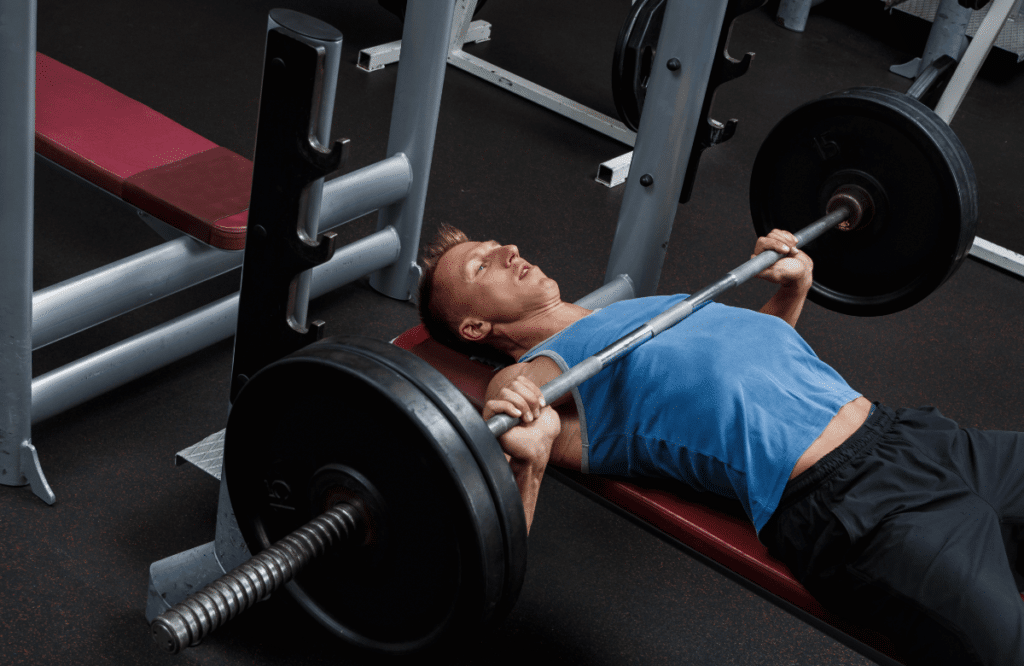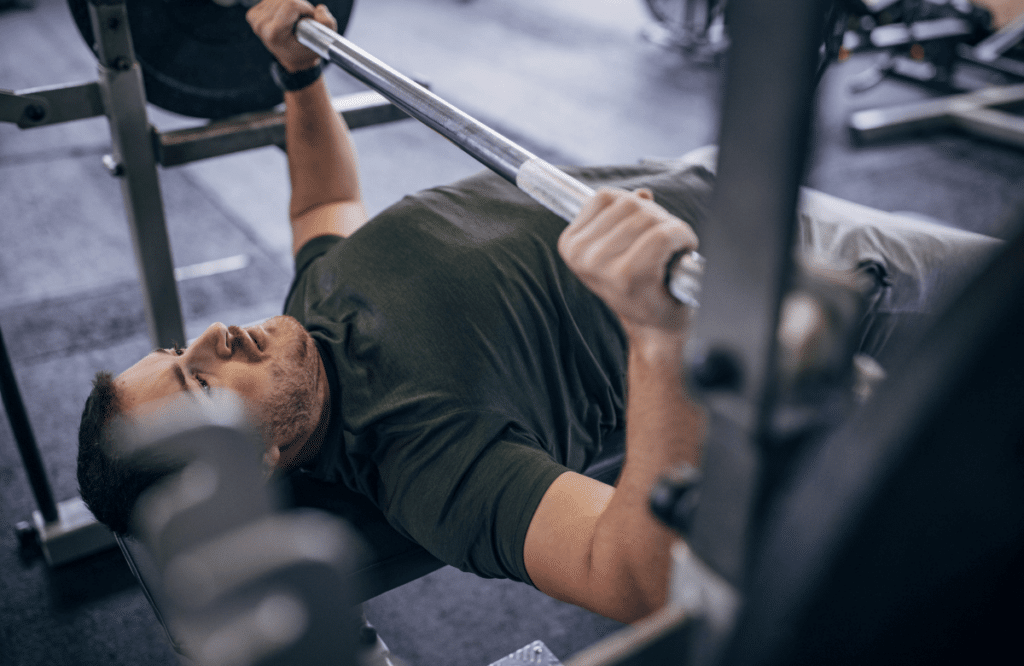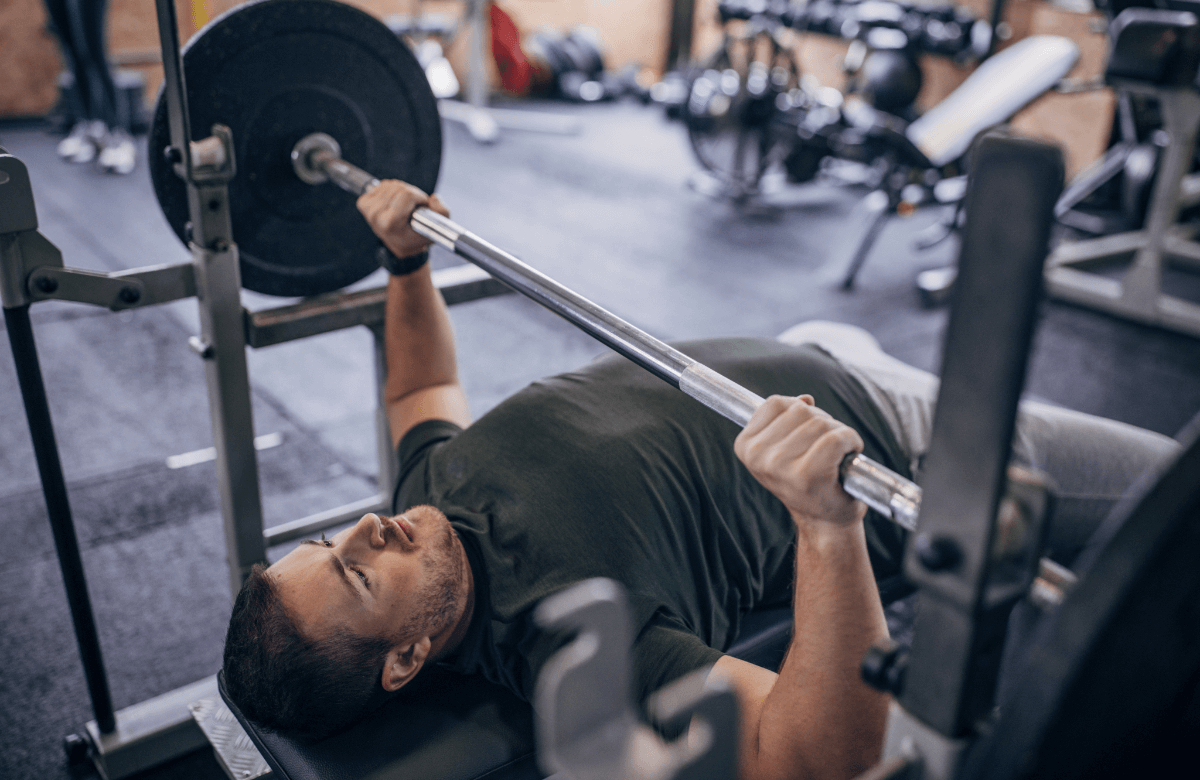Maintaining correct posture and form during weight training is an incredibly crucial aspect of avoiding injuries. Not only are you supposed to tackle the heavy load in a controlled manner, but you also need to ensure that your body is in the optimal position to perform the exercise. When all of these factors are balanced, you’re able to achieve optimal results.
But what happens when you start to feel shoulder pain during bench press exercises? Is there anything in particular that could be causing this discomfort? And how exactly can you mitigate potential shoulder issues when performing this classic exercise? As it turns out, there are a few answers to all of these questions.
Jump to:
What Causes Shoulder Pain During Bench Press?
To get to the root of the problem, you need to determine what causes your bench press shoulder pain in the first place. When you know exactly what leads to the discomfort you’re feeling, you’re able to perform targeted corrective exercises to help alleviate the issue. Not to mention the fact that you can also avoid the mistake in the future and avoid getting into the same predicament all over again.
Labrum Irritation
One of the main culprits that can cause discomfort in the shoulder joint during bench pressing is labrum irritation. The labrum is the ring of cartilage that lines the socket of your shoulder joint to enhance stability. It’s responsible for protecting and keeping the joint in place and facilitating smooth movement. When you’re dealing with heavy weights and improper form during bench press, this delicate structure can get irritated, leading to pain and discomfort.
But what are the symptoms you may ask? Well, the most common indication of labrum irritation is a clicking sensation in the shoulder as you move your arm. This sound comes from the labrum rubbing against bone or other structures within the joint. Continuous clicking sounds may be a sign of more severe issues, so it’s essential to address the problem before it escalates.
You may also experience a deep-seated ache in the shoulder joint or pain when lifting your arm above your head. In some cases, you may even feel like your shoulder is “popping” out of place. If you’re experiencing any of these symptoms, it’s time to re-evaluate your bench press form and make corrective changes.
AC Joint Dysfunction
The AC or acromioclavicular joint is another common reason you may be experiencing achy pain in your shoulder muscles. It’s essentially a small joint that connects your collarbone to your shoulder blade. When you engage in repetitive movements like bench press, this joint can become inflamed and irritated.
While it’s not necessarily a severe issue, AC joint dysfunction can still cause discomfort and pain during bench press exercises. The good news is that it’s relatively easy to manage with proper form and corrective exercises.
The key thing is to identify the origin of the issue – whether it’s an overuse or traumatic shoulder injury. The former normally ties in with an incorrect bench press form, while the latter is commonly referred to as a shoulder separation due to a direct blow to the area. Once you’ve determined this, you can start making necessary adjustments and perform targeted exercises to alleviate the discomfort.
What you want to look out for in both scenarios in terms of symptoms is pain and tenderness in the front of your shoulder. You may also experience swelling, a visible bump on top of the joint, or weakness when trying to lift your arm. Keep a close eye on how your body responds after bench pressing and take note of any discomfort or pain.

Rotator Cuff Dysfunction
Rotator cuff injuries are certainly a typical occurrence when it comes to a workout routine with heavy weights. The rotator cuff is essentially a group of four muscles that surround the shoulder joint and help keep it stable during movement. When these are the active muscles during bench press, you may experience pain and discomfort if there’s an underlying issue.
Rotator cuff dysfunction can stem from a variety of sources – whether it’s weakness in the muscles or poor form during exercise. It could also be the result of previous shoulder injuries that haven’t been given the proper time to heal. Whatever the case may be, it’s essential to identify any potential rotator cuff-related issues and work on addressing them.
Now, it’s worth noting that the rotator cuff muscles may result in some more severe pain and discomfort than the previous two. You may experience sharp pain in the shoulder, radiating down to your elbow or upper back – sometimes even waking you up at night. You could also feel generalized weakness in the muscle fibers of your arms, which could hinder your ability to move them freely and lift them above your head.
Improper Shoulder Rotation
External rotation of the shoulder is an incredibly vital aspect of proper bench press form. What this means is that you need to rotate your shoulders backward, tucking them into the bench as you lower the bar. This is vital as it ensures that your shoulder blades stay retracted and your arms are in alignment with the chest muscles.
Putting your shoulders downwards towards the flat bench pad provides enough support for your arms to lift the weight. If you’re not correctly rotating your shoulders, it may result in excessive stress on the muscles and tendons within the joint. This added stress could lead to inflammation, pain, and discomfort.
It’s essential to keep a close eye on your shoulder rotation during bench press exercises. Remember that the movement should happen gradually as you lower the bar towards your chest – you should never exaggerate the movement or do it too quickly. Keeping a slow and controlled movement will significantly reduce your chances of experiencing shoulder pain while bench pressing.
If you notice that you’re having difficulty keeping your shoulders rotated during bench press, it may be a sign of poor shoulder mobility or strength. In such cases, incorporating targeted exercises to improve these aspects can make a world of difference in preventing future injury and muscle strain.
Elbow Flaring
The correct bench press technique calls for a 90-degree angle at the elbow joint as you’re lowering the bar to your chest. This provides enough room for the pectoral muscles to fully engage and do their job in a much more effective manner. When the angle is excessive, however, you’re causing your elbows to flare outwards and cause more strain on the shoulders.
This mistake is a common one, mainly because of an attempt to lift a heavier weight too soon or want to do more reps than usual. However, the consequences can be quite severe – not only in terms of shoulder pain but also in overall bench press performance.
The onset of this issue is typically when you’re halfway through the set, and fatigue starts to kick in. As a result, your form may start to suffer, and your elbows may flare out as you try to push the weight back up. This movement puts more pressure on the shoulder socket in an effort to compensate for the lack of strength in the chest muscles. This added stress could lead to intense pain and discomfort, hindering your workout progress.
Some of the telltale signs that your elbows are flaring during your workout include an inability to keep them tucked in towards your sides, and you can feel the pressure on your shoulder joints when pushing the weight up. If you’re experiencing any of these symptoms, it’s crucial to reassess your bench press form before continuing with your sets.
Irregular Bar Touch-Point
At a certain point during the barbell bench press, the barbell makes contact with the upper chest. This touch-point is a vital part of the exercise, and it’s crucial to get it right for optimal results. If you’re touching too high or too low on your chest, this could result in pain and discomfort during and after your workout.
Touching the bar too high on your chest means that you’re putting excessive strain on your shoulder muscles to compensate for the lack of engagement by the pectoral muscles. This added stress could lead to inflammation and pain in the shoulders, causing discomfort during repetitive exercises.
On the other hand, if the bar is touching too low on your chest, you’re not allowing the pectoral muscles to engage fully. This could also result in pain and discomfort as other muscles are forced to compensate for the lack of proper form.
The key is to find that sweet spot where the bar touches your chest at an appropriate length away from your sternum – not too high or too low. This contact point will ensure the proper balance between chest and shoulder engagement, reducing your chances of experiencing pain during bench press.
A general rule of thumb is to place the barbell somewhere in between the bottom of the Pectoralis muscle and the upper part of the sternum. This area provides optimal contact with the chest and facilitates the most natural range of motion for your arms.
When you have optimized the touch-point, you’ll notice a significant difference in your bench press form and experience less pain and discomfort during your workouts. You’ll notice a more controlled movement and feel your chest muscles fully engaging as you push the weight up as well as greater stability in your shoulders.

Jerky Momentum Repetitions
While bench press variations are some of the most effective shoulder exercises for strength and size, they can also lead to injury if not done correctly. One common mistake that people make is doing jerky momentum repetitions – where you’re using the momentum of your body to complete a rep, rather than engaging your muscles.
This is because the bench press mechanics put significant emphasis on the shoulder joint in particular, which would otherwise be working together with the chest muscles. When your shoulders are taking on most of the weight and movement, this could result in injury and pain.
Naturally, when the force of the momentum stops when you pause either at the top or bottom of the movement, your shoulders may be subjected to unnecessary pressure. This will imminently lead to more wear and tear over time, but when you pay special attention to slowing down the momentum before actually stopping, you can correct your form and ensure that your shoulder muscles are working together with your chest.
How to Manage Shoulder Pain During Bench Press?
After addressing the causes of shoulder pain from bench pressing, you need to turn to potential solutions. Some may be easier to pull off than others, but they all aim to get you back on track with your bench press exercises and help you reach new personal records.
Change Your Grip Width
If you want to facilitate a pain-free bench press workout, your grip width is something to consider. The wider your grip is, the more you’re using your shoulders and triceps rather than engaging the chest muscles. This could be putting extra strain on the shoulder joint and causing discomfort.
Many see this as the first line of defense against shoulder pain during bench presses, and it’s something that you can easily try out for yourself. Narrow your grip width slightly and see if this makes a difference in how your shoulders feel when performing the exercise.
If you’re already using a narrow grip, try making a shift in your shoulder position to alleviate some of the stress on the sensitized structures, such as the rotator cuff. Sometimes, this involves moving the elbows closer or farther from your body, and this may help to change the angle of the exercise for you.
Keep Your Shoulder Blades Retracted
Another technique that you can use to reduce shoulder pain during the bench press is keeping your shoulder blades retracted. This helps create a more stable platform for the barbell and effectively reduces the chances of experiencing pain in this region.
This is directly related to the muscle imbalance issue that occurs when you’re experiencing shoulder pain during the bench press. By keeping your shoulders retracted and down, you’re effectively engaging the muscles in this area and giving them more strength to support the weight of the barbell.
If you notice you keep pushing your shoulder blades upwards, try placing your elbows slightly farther from your body and squeezing your shoulder blades together during the bench press movement. When you lower the barbell, make sure not to flare your elbows or lose contact with the bench, as this can cause you to lose your shoulder blade retraction.
If you notice your shoulder muscle group activation seems to be insufficient, you can also try protracting your shoulder blades – the opposite of retracting them. This will likely force you to limit yourself to a narrower grip width, which may be better for your shoulders.

Give the Low Incline Bench Press a Try
When you have an adjustable bench, you have the option to modify the angle of your bench presses. Not only does this increase the variety in your workout routine, but it could also relieve shoulder pain because you’re not using the same angle every time.
Try performing low-incline bench presses, where you’re at a slightly inclined but still flat position, to alleviate some of the stress on the shoulder joint. This will also help engage your upper chest muscles and give your shoulders a break from bearing all the weight.
If you’re used to doing incline bench presses, consider giving this variation a try and see if it makes a difference in how your shoulders feel during and after your workout. Take a closer look at the way your shoulders are positioned, and make adjustments as needed to keep them in a more comfortable position.
If you think a bigger incline might be more suitable for your shoulder health, try adjusting the bench to 30 degrees rather than the standard 45-degree angle. This will alter the movement pattern of the exercise and shift some of the focus from your shoulders to your upper chest.
Up Your Overhead Pressing Volume
Oddly enough, one of the best ways to address joint pain and injuries is to train the muscles that surround the area. You’d think giving them a rest would be the best course of action, but it’s not that simple. Oftentimes, the issue persists even after you’ve taken a break from bench pressing simply because your body can’t handle the weight and the movement pattern you’re putting it through.
Luckily, there’s a fix – by increasing your overhead pressing strength, you’re effectively buffing up the muscles that support the shoulder joint. This will help offload some of the stress and pressure from bench pressing, allowing you to perform the exercise with less discomfort and pain.
Consider adding more overhead pressing exercises into your workout routine, such as dumbbell shoulder presses or military presses. These exercises also allow for different ranges of motion and angles, making them a great complement to your bench press workouts. You don’t necessarily have to go heavy since slow yet steady progress is key when it comes to shoulder health.
Do Posterior Shoulder Soft-Tissue Work
Your upper body muscles are interconnected, and when one group is not functioning properly, it can cause a domino effect of issues. In the case of bench press-related shoulder pain, your posterior shoulder muscles – mainly your rear deltoids and rotator cuff – may be weaker and more strained than your anterior muscles.
To address this muscle imbalance, make sure to do some soft-tissue work on the back of your shoulders. This includes foam rolling, massage therapy, or any other form of self-myofascial release that can help relax those tight muscles and improve blood flow in the area.
Incorporating posterior deltoid exercises into your routine can also facilitate muscle growth and balance, which can ultimately alleviate shoulder pain during bench press. Some exercises to try include reverse flys, face pulls, and band pull-apart.
FAQs
Why does my shoulder hurt when I bench press?
Upper body exercises like the bench press can cause shoulder pain if you practice poor technique and fail to achieve proper form. This can be caused by issues like rotator cuff dysfunction, elbow flaring, or improper shoulder rotation. Other factors such as muscle imbalances, jerky momentum repetitions, or an irregular bar touch-point can also contribute to some discomfort.
Does shoulder pain go away?
Shoulder pain can go away with proper management and rest. It’s important to address the underlying causes of your shoulder pain, such as muscle imbalances or improper form, in order to prevent it from recurring. Seeking guidance from a physical therapist and incorporating exercises that target the posterior shoulder muscles can also help alleviate pain and discomfort.
How can I tell if shoulder pain is serious?
It’s crucial that you pay attention to your body and listen to any pain or discomfort you may be experiencing. If the shoulder pain is mild, it’s possible to continue bench pressing with some modifications in form and grip width. However, if the pain persists or becomes more severe, it’s best to rest and seek guidance from a professional, particularly if you’re experiencing severe aches.














